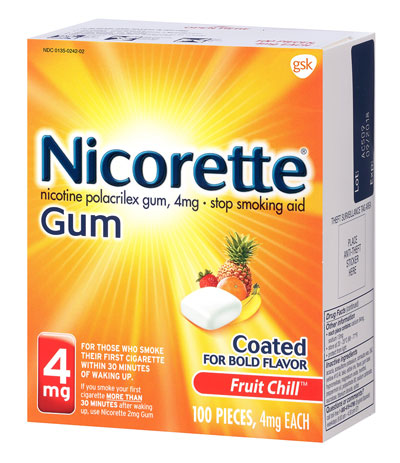Nicorette, Tylenol Ease J&J's Consumer Pain From Slow Oral Care Sales
Executive Summary
J&J’s worldwide OTC drug division sales rose 4.4% to $1bn, driven by the Tylenol and Nicorette brands, the firm reports Oct. 17. Those revenues helped offset softness in the firm’s Listerine and other oral care products due to more competition online from start-ups selling straight to consumers.
Nicorette smoking cessation and Tylenol analgesic OTC drugs helped drive 6.3% worldwide growth for Johnson & Johnson’s consumer health business in the third quarter, buoying the unit as its oral care lines struggled against firms selling direct to consumers online.
Total OTC drug sales were slightly more than $1bn, helped by a 1.9% gain from currency exchange. US revenues, unaffected by exchange rates, grew 3.9% to $401m and the international business was up 4.7%, including a 3.2% currency boost, to $601m for the July-September period, the firm reported in an Oct. 17 earnings release.
J&J’s Nicorette nicotine replacement therapy brand had strong sales of its patch, gum, spray and lozenge products after the firm launched a digital app that promotes community support to help consumers quit smoking.
The UK download webpage says the "Nicorette Stop Smoking App combines the latest behavioral change science with over 40 years’ worth of quit smoking expertise" and tracks users' "progress as it happens through personalized weekly goals and milestones," including the amount of time without smoking and money saved in that period.

The Nicorette nicotine-replacement therapy line was a key driver for J&J's third-quarter OTC drug sales.
The app is designed for users to "build new healthy habits and break the cycle of addiction" by understanding cravings, identifying smoking triggers and when necessary receiving "personalized distractions, to keep you occupied and smoke-free," the download page says.
J&J during the quarter also won a Cannes Film Festival-related award for an ad campaign it ran for Nicorette in the UK in 2016. (Also see "Colgate Boosts Digital Marketing 20% To Engage With Consumers" - Pink Sheet, 12 Sep, 2017.)
The firm said Tylenol Rapid Release formulations were a key OTC drug sales driver.
The brand's adult and children’s products continue to gain market share since the company remediated three manufacturing sites under a 2011 consent decree with FDA due to good manufacturing practices problems, the firm said. J&J pulled numerous OTC products from the market and relied on contract manufacturers to make some of those products while remediating its sites, a period in which it lost significant market share across OTC categories, particularly to private label and store brand products. (Also see "J&J/McNeil Completes Remediation Under Consent Decree" - Pink Sheet, 7 Sep, 2015.)
OTC drug and beauty products drove 1.6% growth in total third-quarter sales for J&J's consumer business to $3.36bn. US sales were flat, off 0.5% to $1.29bn, while the international division grew 3% to $2.07bn.
Hurricane Response Helps
Leerink analyst Danielle Antalffy noted in a report that J&J’s consumer health division performed “surprisingly well” considering manufacturing disruptions caused by hurricanes Irma and Maria striking Puerto Rico during the quarter.
During the earnings briefing, Chief Financial Officer Dominic Caruso said the firm has six manufacturing sites on Puerto Rico, where much of the island remains without power, water and other services after being hit by Hurricane Maria on Sept. 20, five days after Irma hit the US commonwealth. “Considering the magnitude of the storm, our facilities fared well. All of our sites are open with reliable generator power, operating in various stages of capacity,” Caruso said.
“While we cannot rule out the potential for intermittent shortages of certain product formats, many of our products have dual production sites and backup supply outside of Puerto Rico to help beat demand. Based on what we know today, we do not foresee any material impact of future results.”
However, sales of J&J’s Listerine, Rembrandt and other oral care brands are slumping in the face of growing competition online. Oral care sales fell 1.3% in the US to $154m and declined 1.4% internationally to $228m; worldwide, sales slipped 1.3% to $382m.
Pharmaceutical sales growth of 14.6% to $9.7bn drove total sales for the company up 10.3% to $19.7bn in the quarter, though higher spending drove net earnings down 11.9% to $3.8bn, the firm said. (Also see "J&J Immunology Growth Now Hinges On Stelara, Tremfya After RA Setback" - Scrip, 17 Oct, 2017.)
The firm increased its 2017 earnings per share guidance to $7.25-$7.30 from a previous midpoint of $7.17, and its sales guidance to $76.1bn-$76.5bn, from a previous midpoint of $75.95bn.
'Fundamental Shift' In CPG Sales
Reminded by an analyst during J&J's same-day earnings briefing that "there are lot of strategic questions investors have about the impact of Amazon on the broader consumer business, the impact of millennials on brands," Mesquita acknowledged that sales growth more and more will be driven by e-commerce across consumer packaged goods categories.
"There's no doubt that the broader CPG industry is seeing a change in the competitive landscape, and there is a fundamental shift here enabled by digital technologies, and we see the rise of a lot of small companies that are now competing with the large established companies in this field," the consumer division chief said.
J&J isn't behind the curve, though, he added, and major operational changes should help it stave off online competition and improve oral care and other consumer health category sales.
“In particular, we have to drive accelerated growth on the online channel, and we’re doing just that. We are growing, we estimate at this point, at twice the rate of the broader online channel with our e-commerce capabilities. We are investing very heavily in leadership, in systems in capabilities in general, in sales fundamentals online so that we drive our share of e-commerce to match our offline share,” he said.
In an investor conference presentation in September, Mesquita said the firm will increase its online investments eightfold over the next two years. (Also see "Legacy Consumer Health Firms Invest To Compete In Start-Ups' Realm: E-Commerce" - Pink Sheet, 12 Sep, 2017.)
The emerging online, direct-to-consumer firms include Hello Products LLC with toothpastes free of synthetic ingredients and Brandless Inc., a recently launched online platform with off-brand toothpastes, soaps, feminine hygiene and other products at $3 each. (Also see "Legacy Consumer Health Firms Invest To Compete In Start-Ups' Realm: E-Commerce" - Pink Sheet, 12 Sep, 2017.)
An analyst also prodded Mesquita on whether J&J would pick up any brands potentially made available by Pfizer Inc., which announced Oct. 10 it is considering a potential sale of its consumer business. J&J is considered by some analysts as a top candidate for purchasing divested Pfizer brands. (Also see "Pfizer Déjà Vu: Is It Time To Sell The Consumer Health Business?" - Pink Sheet, 10 Oct, 2017.)
J&J's decisions on acquisitions swing on "value creation" Mesquita said. "That’s the overriding criteria that we use to establish whether or not we have an interest in a particular asset. So as assets become available, we systemically evaluate them.”
'Branding Power' Slipping?
Sales for the baby care segment, which includes Johnson’s shampoos and body washes, also were hit by direct-to-consumer competition during the quarter. US sales plummeted 15.3% to $100m, international markets were flat at $377m and the segment worldwide fell 3.6% to $477m.
Still, Mesquita said J&J remains the market leader in the space and will continue to work on relaunching its baby care lines in 2018.
It reformulated Johnson’s baby products in 2012 to remove formaldehyde releaser preservatives and minimize 1,4 dioxane in response to consumer demand. (Also see "J&J To Phase Out Quaternium-15 In Baby Shampoo In Response To Demand" - HBW Insight, 7 Nov, 2011.)
Morningstar Equity Research doesn't expect J&J's baby and oral care lines to return quickly as revenue drivers for the firm. "Weakness in consumer," is contributing to "some weakening of the company’s moat" against overall earnings downturns, "especially in branding power for the baby and oral care lines," said Damian Conover, Morningstar's sector director, in a same-day note.
Conover added that other than consumer and medical device segments, its "lines are performing well and we still view the company’s wide moat as intact."
Growth on the consumer side is “stagnating” with increased pressure from online distribution, but he said he expects increased investment in brands will help the segment to achieve 3% annual growth by 2018.
From the editors of The Tan Sheet.
